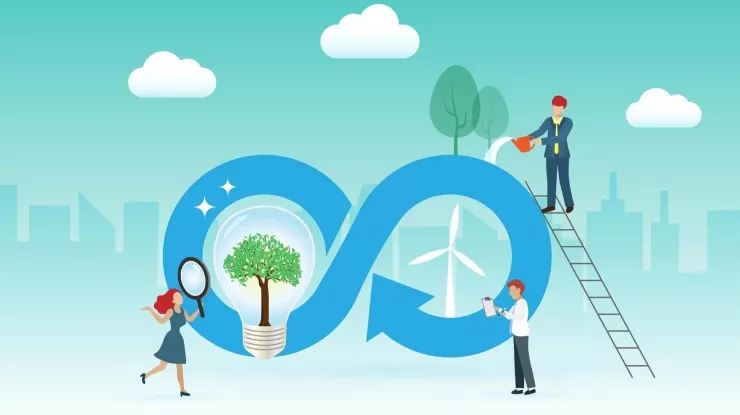A sustainability strategy for your small business can help you attract new employees and new clients, as well as contribute to a greener environment. And becoming a green business can have a big impact on your bottom line. Here’s how to develop a sustainability strategy for your business.
What is a Business Sustainability Plan
Sustainability means meeting our own needs in a way that doesn’t compromise the ability of future generations to meet their own needs.
A business sustainability plan lines out how the company will achieve goals on your “triple bottom line” – financial impact, community impact and environmental impact.
Why Build a Sustainability Plan for Your Business?
Maybe you’ve looked at ways to be more sustainable at your small business.
You want to be an eco-friendly company. You make sure to turn off the lights at the end of the day. There are recycling bins in the lunch room. And you’ve had an Earth Day event each year. Those are good steps. But these are short term actions that don’t make a lasting impact or a lasting impression.
A sustainability strategy means you are walking the walk, not just talking the talk about being a green business.
And when sustainability becomes part of your corporate culture? It can make a real difference to your company’s triple bottom line of people, profits and planet.
According to Forbes magazine, Generation Z (born between1997 and 2012) and Millennials born 1981 to 1996) are more likely to make purchasing decisions based on their values and principals.

That’s important for your small business. Because Gen Z makes up 40% of consumers in the US, and Millennials comprise another 22% of consumers in the US. But it’s not enough to slap a green label on your business. These consumers want to do business with companies that are authentically committed to doing the right thing.
That’s the bigger picture. Now let’s dive in to how to address one of the three pillars of sustainability: environmental impact.
Six Steps to Developing a Sustainability Strategy for Your Small Business
Consider energy efficiency and sustainability with a holistic approach. Sustainability will provide a better work environment for your employees, and you’ll have savings that can improve your profitability.
The ideal? That your energy efficiency project can be 100% paid for with cost reductions in water and energy. Here are the six steps to implementing energy efficiency and sustainability for your small business.
Step 1: Benchmark Your Current Usage
The first step to developing an environmental sustainability strategy for your business is benchmarking.
That allows you to set a baseline for your current energy and water consumption. It also helps to identify areas where you can improve vs. comparable buildings.
In the US and Canada, EnergyStar.gov’s Portfolio Manager tool is the standard for energy benchmarking. It contains energy data on over 25% of all buildings in the U.S. You’ll be able to enter your current usage data and information on your operations. Then you can compare your operations to similar ones to see where your company is underperforming.
Step 2: Conduct an Energy Audit
Once you know where you stand versus comparable buildings, your next step is an energy audit.
The energy audit includes inspections of lighting, air conditioning, heating and ventilation equipment, controls, refrigeration, air compressors, water consuming equipment. It includes anything that uses energy, from the coffee pot to the lights in your elevator to space heaters tucked away under desks.
Any energy professional you work with will use energy audit standards and guidelines developed by the American Society of Heating, Refrigeration and Air-Conditioning Engineers (ASHRAE). You’ll need this level of professional audit to back up some of your financing options, which we’ll discuss below.
Here are some options for your commercial energy audit.
- DIY Business Energy Audit. With a DIY business energy audit, you’ll collect information on your current facility.
- ASHRAE Level 1 Audit. This is a walk-through audit of your commercial building. It involves interviewing operations staff, reviewing utility bills and a basic review. With this audit, you’ll identify low-cost efficiency options and your low-hanging fruit for energy efficiency.
- ASHRAE Level 2 Audit. Once you’ve conducted a walk-through audit either with an ASHRAE level 1 or DIY audit, you may want a more detailed Level 2 Audit. This includes energy calculations and a full financial analysis of energy efficiency measures. This will include analysis of energy bills, including any interval time of use data your company has access to through your utility smart meter.
Step 3: Identify Areas of Improvement
Work with a mechanical engineering firm, engineering or consulting firm to review the results of your energy audit. You’ll identify not only what needs to be replaced, but what kind of energy savings you can expect.
Here are some other items you’ll want to consider:
- As part of your energy audit, you’ll want to take a close look at your electricity bill to check your rates. Many states (including Texas, Ohio, Connecticut, Pennsylvania, Illinois and New York) are deregulated for electricity, allowing you to shop for the lowest business electricity rate.
- When you review your bill, pay close attention to your demand charges. Managing your usage on “peak demand days” when the grid is at its highest usage will cut your electricity bills. It also reduces your environmental impact.
- Don’t forget to involve your employees in energy savings for your business. You could find the HVAC isn’t cooling uniformly, leading to some employees using desk fans while others use space heaters.
Areas of energy efficiency improvement for your commercial building may include:
- Building Envelope – the separation of the interior and exterior of a building, which helps you facilitate climate control and protect the indoor environment
- Building Automation and Controls Systems
- Water and Wastewater Reduction
- HVAC
- Lighting
- White Roof Installation – which can reflects 60-85% of the sun’s heat
Keep this tip in mind too:
If you combine lighting measures, building controls and HVAC improvements, you’ll usually have a better ROI than doing one system at a time. A deep retrofit gives more results than just changing out the lights.
Gavin Dillingham, Director of Clean Energy Policy at Houston Advanced Research Center
Step 4: Identify How to FInance your Sustainability Improvements
Once you’ve identified your areas of focus, start researching ways to finance your sustainability program. Check into these options before you start scoping equipment purchases to get the best return on your program.
- First, contact your local utility company for rebates and incentives. For example, in Texas, Centerpoint Energy’s Standard Offer Program provides incentives to new or existing facilities that are upgrading for energy efficiency. AEP Ohio offers a Commercial Energy Efficiency Rebate Program. In fact, most utilities offer these free programs to meet state requirements for conservation.
- Second, talk to your tax accountant about federal energy efficiency deductions. Your state may also offer incentives for energy efficiency, such as the Advanced Energy and Efficiency Program in Ohio.
- Third, find out about your state’s Property Assessed Clean Energy (PACE) program. PACE financing gives qualifying companies access to a lower cost of capital for energy efficiency upgrades.
Texas businesses that want to develop a sustainability strategy have access to an array of tools from the Houston Advanced Research Center (HARC), a non-profit that studies energy consumption and sustainability. HARC has worked with Keeping PACE in Texas to create the Texas Clean Energy Hub. Within the site, you’ll find tools to help you implement best energy practices, estimate costs and build a business case for financing. Here are just some of the tools available online:

“When you combine incentives, rebates, and PACE financing, you end up with a project with a good payback,” says Gavin Dillingham, Director of Clean Energy Policy for HARC. “Instead of capital outlays, you’re paying for the project out of your savings in operating costs.”
An additional tool, the Energy Star Cash Flow Financing calculator, can help you estimate how much new equipment you can finance through your anticipated operating cost savings.
Step 4. Implement Energy Efficiency Measures
You’ve lined up your financing, selected a vendor to manage the installation and selected your new systems. Now it’s time to implement these energy efficiency measures.
Don’t forget to communicate with employees regarding your new energy efficiency program. Your communication plan should include why you’re making changes, the improvements you expect and how this fits into the bigger picture of your sustainability commitment.
And of course, you should address the universal interest, “what’s in it for me.” Explain how these changes will improve the working environment for employees.
Step 5. Perform Continuous Evaluation of Energy Usage
Once you implement your energy efficiency measures, you’ll want to continue to measure the results.
You may need to tweak your building controls or work on your HVAC balancing to the get the results you want. Or maybe you’ll need to install smart plugs or smart power strips that can turn off all the monitors in your building at a certain time. Little changes can make the difference.
One building engineer we spoke with ran through a complete building retrofit, working with building controls, HVAC and wastewater reduction. But they didn’t stop there. For further reductions, they measured the electricity usage for their all-day coffee pots and made changes to the break rooms. And changing out the lighting in their elevators dropped their usage by another 1%.
Step 6. Revisit and Revise Your Sustainability Strategy
Your sustainability strategy should be part of an ongoing process. It’s not something to put in a binder and file away on the bookshelf.
You should monitor your progress each month. And when you’ve reached the benchmarks you established in step 1? Keep going. The more you can reduce your energy usage, the more economic, personnel and social benefits you’ll receive.
Do’s and Don’ts For Managing Energy Efficiency Projects
Don’t: Wait until something breaks down. If it’s an emergency replacement, you may pay more for equipment.
Do: Take a whole-building approach for maximum return on your investment.
Do: Talk to your utility company to find out about energy efficiency audits for businesses
Demand Response as Part of Sustainability
Demand Response or DR refers to voluntary reduction in electricity demand to help maintain grid reliability.
During peak usage times, your local grid operating system (such as ERCOT, MISO, PJM) may call for a reduction in usage. These voluntary reductions have the ability to flatten electricity usage during weather-related demand peaks. That keeps the grid system in balance to avoid possible blackouts or brownouts. DR also helps to keep less efficient generation assets from coming online.
When you participate in demand response, you may receive payment for your voluntary usage reductions.
Typically, demand response programs are targeted at large volume users such as:
- Supermarkets
- Manufacturing facilities
- Warehouses
- Universities
- Hospitals (with backup power generation)
- Commercial office buildings
Contact your retail electricity supplier or utility to find out about participating in DR.
